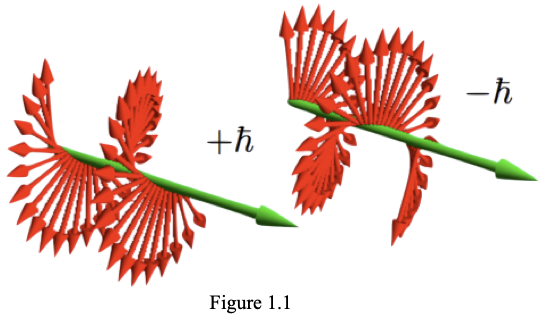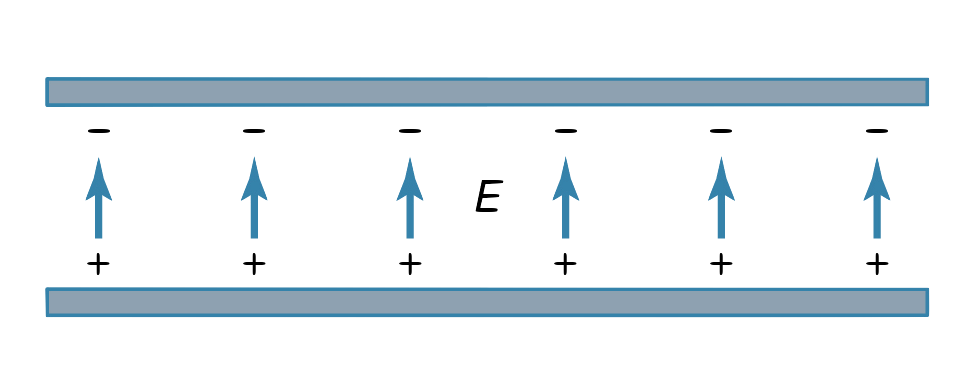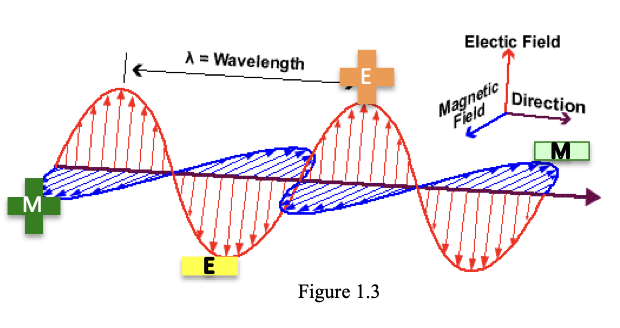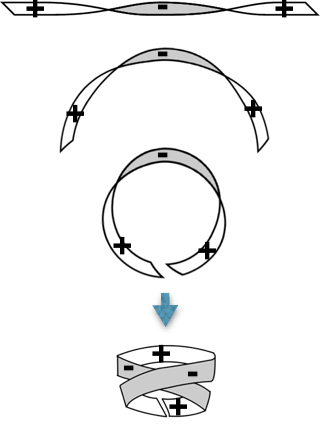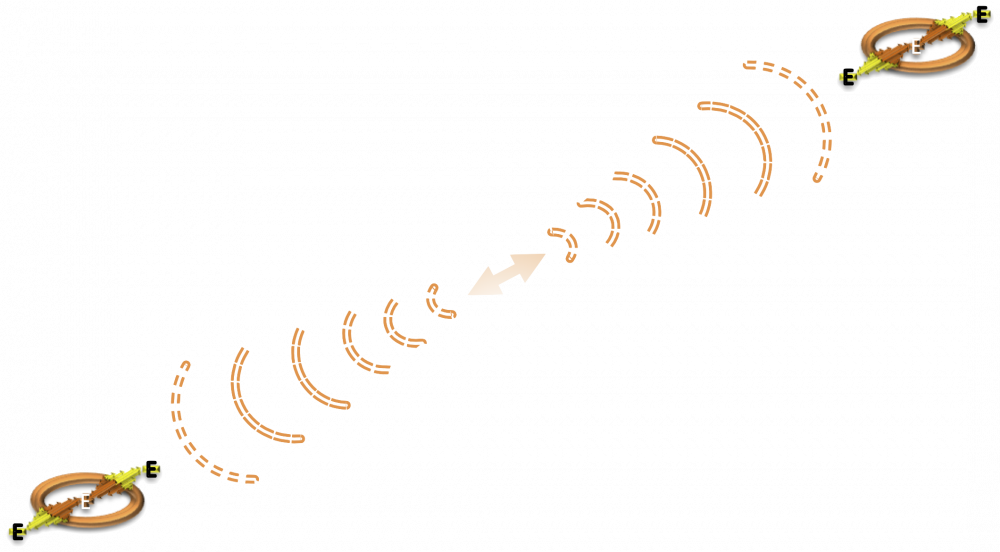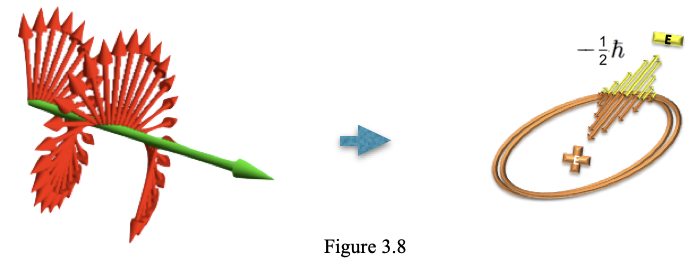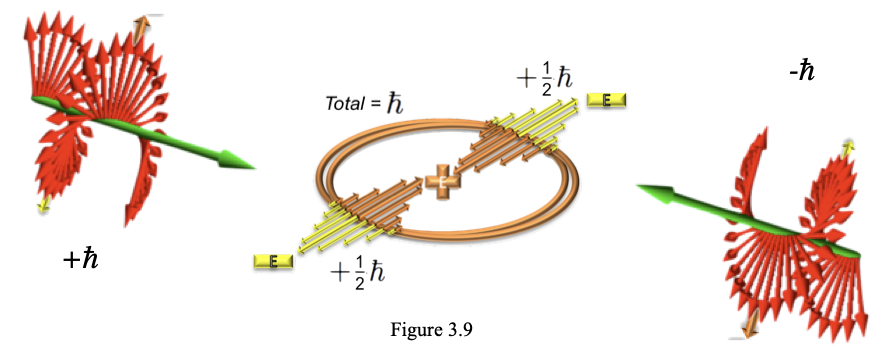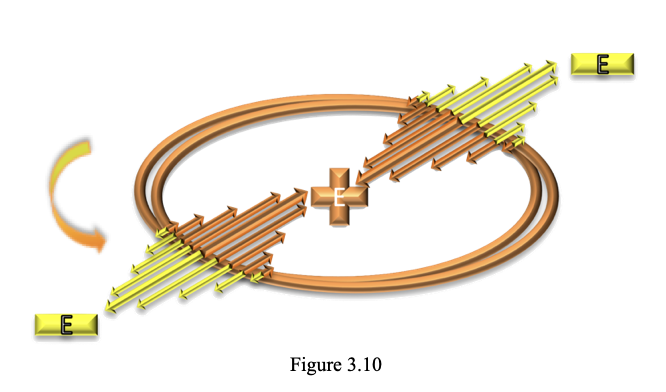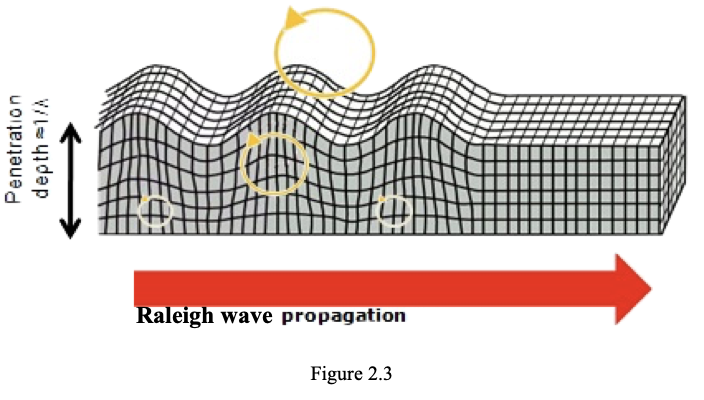-
Posts
50 -
Joined
-
Last visited
Content Type
Profiles
Forums
Events
Everything posted by Spring Theory
-

The Deterministic Ring Theory of Particles
Spring Theory replied to Spring Theory's topic in Speculations
I propose that there is no separation. They are infinitesimally close together (on top of each other so that the opposing magnetic fields align. Maybe I should go back to the absurd assumption about the photon. It is described at the quantum level with a spin of 1 and its electric field pointing along that spin as in Figure 1.1: Two oppositely charged plates have an electric field pointing from one to the other: The flawed assumption is that the photon can be modeled with a directional charge in a ribbon form: The argument that there is no charge, just an electric field, can be equated to there is a directional charge with the net effect zero. When the photon becomes polarized, the charges end up with peaks in the popular wave description and the opposing magnetic fields are presented: I propose the only way to naturally polarize a single photon is if it circles itself into a double orbit" After the collapse, the photon is now polarized and the electric charge points align: And the opposing magnetic fields align: And the dipole is formed. Defining charge as compression/decompression of space on wave fronts results in the deterministic model for particles. The inner charge is shielded to present a charged particle. Some very interesting properties fall out from these assumptions including the structure of the proton using three photons in orbit. Also a physical description of the wave function. -

The Deterministic Ring Theory of Particles
Spring Theory replied to Spring Theory's topic in Speculations
The next step is to determine the speed of the electron orbit, which is what I used in the above calculations. If we have (2) 1/2 ħ photon dipoles in orbit, then the total angular momentum would be about ħ: [latex] v_c =\frac{\hbar}{r_em_e} [/latex] = 4.108235899773E+10 m/s Plugging in the generally accepted values in this equation yields a rather high speed of the photon of about 137 times the speed of light. This normally leads to pause, and calls for the fact that nothing (especially something with mass) can move or spin faster than light. Another way to look at the concept is not that nothing travels faster than the speed of light, but that nothing travels faster than a photon. The photon, though, has variable speeds through space, especially trapped in ring orbits to form particles. The complete ring particle structure still has a speed of light limit though. Analyzing this calculated speed, which I will label the “Dirac velocity”, with the speed of light in a vacuum in a ratio is an interesting discovery: [latex] \frac{c}{v_c}= [/latex] 0.0072973525696658 = α = 0.0072973525693(11) This is close to the fine structure constant, within the standard uncertainty. An explanation for this high velocity is the positive charge on the inside of the electron. High compression of space means high photon velocity as show in Figure 3.12: -

The Deterministic Ring Theory of Particles
Spring Theory replied to Spring Theory's topic in Speculations
No, every electron has a positive charge inside it. If the dipole is a negative radius outside, then the inside radius will be positive and could be one mechanism (hand waving) to hold the photon pair together - gravity. If you take each dipole as half the mass and a positive radius from one dipole inside the electron to the other dipole, then gravity be the attraction for the two positive radius points inside the electron. The centrifugal force experienced at the dipoles is: [latex] F = ma = \frac{\frac{m_e} {2} v^2}{r_e} = 2.7342903649E+05 N [/latex] The gravitational force required to keep the photons in orbit at the classic electron radius would be: [latex] F = \frac{Gm_1 m_2 }{r^2} = \frac{G \frac{m_e} {2} \frac{m_e} {2} }{r^2} = \frac{G m_e^2} {4 r^2} [/latex] Since the radius is modeled as a pulse curvature inside the electron, these could potentially get right next to each other. The radius at which the gravitational force equals the centrifugal force: [latex] r = \sqrt { \frac {Gm_e }{4F} } [/latex] = 7.11605989070E-39 m The result is smaller than the Planck length. Would this be a problem? I'm interested. What experiments? -

The Deterministic Ring Theory of Particles
Spring Theory replied to Spring Theory's topic in Speculations
Yes, my Lagrangian is semi complete because I have chosen a photon propagating along the path of the z axis. It does however produce all the known properties of the photon when you derive the equations of motion. Hang in there, gentlemen. I didn't do any of this with motivated reasoning, I just started with these assumptions and everything just fell out of it. I'm confident you guys will have an aha moment when it all clicks. You're combining a black hole and a particle. I'm saying two photons can be retained in an orbit but the black hole is the genesis. I'm also not sold on the virtual particle thing. This may be a side effect of the dipole structure of perceived particles. So black holes may never evaporate. The dipole was formed when the photons magnetic field intersected in orbit per my previous graphic of the deterministic electron. The electric fields also intersected. There is a Princeton paper that describes the destructive interference that would happen with EM waves that results in an amplification of the electric fields: http://kirkmcd.princeton.edu/examples/destructive.pdf The classical radius is the best example we have as it has not been disproved in experiment. -

The Deterministic Ring Theory of Particles
Spring Theory replied to Spring Theory's topic in Speculations
So if you model the radius of the electron with a negative radius pulse at each dipole, a potential candidate for the radius formula would be: [latex] f(x)= r^2-\dfrac{\left(\frac{k}{\cos^2\left(x\right)+k^2}+r\right)^2}{2} [/latex] A graph of this with the radius at 1 looks like: If you plug this formula into an integral calculator you get: [latex] \int_{0}^{2\pi} f(x) = {\pi}r^2 [/latex] So the area is the same as the area of a circle. This makes the overall curvature of the electron and mass based on its classical radius. At the dipoles you have a negative radius pulse (negative curvature) which is what presents negative charge. For a positron you will have positive pulses at the dipoles pulsing positive curvature which presents positive charge. Now we have a mechanism behind charge. When a positive curvature (positive charge) meets a negative curvature (negative charge) they reinforce to create an attraction effect. When a negative curvature meets a negative curvature they oppose to create a repulsive effect: The overall curvature of the electron is still positive per the integral above, but the charge is represented by negative curvature pulses. The electron is spinning so Maxwell's equations are approximations as a point source. -

The Deterministic Ring Theory of Particles
Spring Theory replied to Spring Theory's topic in Speculations
I'm assuming you believe that black holes exist. Then you should see that it can bend space so much that a photon will curve its path around it. This is the photon sphere. Now make the black hole dense enough so photon sphere has the radius of an electron. In a radio, a wire receives the electromagnetic wave. The wave causes current to flow one direction and then the other as it oscillates. I'm not changing the mass of the electron. You can take those equations an add in a positive contribution and then add in a negative contribution. The result is you get the same equation. The Langragian of the photon that I derived is as follows (cylindrical coordinates): [latex] \mathcal{L} = \dfrac{\hbar \dot z^2}{ r_c^2 \dot \theta} {} + {2\hbar \dot \theta} - \dfrac {\hbar \dot z}{ r_c} [/latex] There is also a kinetic energy term for the charge in the form: [latex] KE_{charge} = \frac{1}{2} m_e \dot{r^2} [/latex] You would have one momentum term for positive charge (positive mass) and another term for negative charge (negative mass) which would cancel each other out. And now we get to what charge is. It is the radius momentum pulse at each electric field peak of the photon. You can model the radius as the classical radius but with a Dirac delta function like pulse at the dipole. Negative charge pulses a negative mass (negative radius) and positive charge pulses a positive mass (positive radius). -

The Deterministic Ring Theory of Particles
Spring Theory replied to Spring Theory's topic in Speculations
Each dipole has a spin of 1/2 which is the only interactive part of the electron. Any experiment will hit one of the dipoles and measure half spin. Two total dipoles makes a total spin of 1 (about). The same logic that you cannot have an electric field without a charge. If the photon has an electric field then what is the source, magnetic field? If it has a magnetic field then is it positive or negative? The answer is it has both. Between (2) charged plates, with the positive on the bottom and the negative on the top, the electric field points up. If you say the photon has an electric field pointing is some direction, then there has to be a positive side and a negative side like my ribbon graphic. The non-charge is net zero charge. The absurd premise here is that the photon has an oscillating charge so the net effect is no charge. -

The Deterministic Ring Theory of Particles
Spring Theory replied to Spring Theory's topic in Speculations
This speculation requires that you accept the possibility of the absurd premise. -

The Deterministic Ring Theory of Particles
Spring Theory replied to Spring Theory's topic in Speculations
Photons have magnetic fields. If a photon wraps around itself its magnetic fields that point in opposite directions will also align. Black holes have quasar events. I propose that these are matter being emitted from the black hole, not incoming matter being ejected. According to GR (light cone diagram shows this), anything that enters the black hole is destined to end up at the singularity. A spinning black hole has a singularity ring instead of a singularity point. So another prediction is that there are only spinning black holes but this may be already generally accepted. Anything that enters the event horizon travels to the center. What I propose is the matter breaks down into its photon components to bend around the singularity ring. Enough photons collect to collapse and create degeneracy pressure. This is the genesis of the quasar event that streams matter and photons from the center along the axis of rotation.- 85 replies
-
-1
-

The Deterministic Ring Theory of Particles
Spring Theory replied to Spring Theory's topic in Speculations
No, an electron has positive charge at its center which is really compressed space. A black hole can create electrons. The positive and negative indicate current flowing. It flows one way then another. All you would need is a black hole with a Schwarzschild radius of at least the radius of the electron. The Schwarzschild radius is: [latex] r_s = \frac{2GM}{c^2} [/latex] This means its mass would need to be: [latex] M = \frac{ r_ec^2 }{2G} [/latex] = 1.8973060E+12 kg The mass of a photon with a planck length wave length: [latex] m = \frac{ h}{\lambda_{pl} c} [/latex] = 1.367493897E-07 kg So the number of Planck length photons occupying the same space required to make a black hole would be 1.3874329E+19. -

The Deterministic Ring Theory of Particles
Spring Theory replied to Spring Theory's topic in Speculations
I was getting there, but it's hard to comprehend without these fundamentals. The nonsense comment is not very nice. The short answer is photons are put into orbit by bending space. The most likely candidate to bend space in this manner would be a rotating black hole with the particle created at the center. Once the opposing magnetic fields align you have a mechanism to keep the photons bound in the orbiting state. Each photon affects its pair by bending space to create a gradient in velocity such that the angular velocity is constant. The formed particles are expelled out of the black hole through quasar events which fall around the galaxy as the spiral arms as mostly protons and electrons to make hydrogen. -

The Deterministic Ring Theory of Particles
Spring Theory replied to Spring Theory's topic in Speculations
The Mass of the Electron: As derived from previous de Broglie’s momentum formulas for the photon, the mass formula is expressed as a function of velocity and curvature radius: [latex] mass =\dfrac{\hbar}{r_cv_c} = \dfrac{h}{2 \pi r_cv_c} = \dfrac{h}{\lambda _{db} v_c} [/latex] Where rc is the curvature radius and vc is the velocity along that curvature. The familiar ħ is the reduced plank’s constant (h divided by 2π). This designation of mass of the photon was the fundamental reason why the photon has momentum, but the idea of open curvature is why it has evasive relative mass to other objects. It is often stated in physics that photons have no mass and any object with no mass travels at the speed of light. As the photon collapses into a double orbit, its end point joins with its beginning point to create closed curvature. The mass now presents itself to all relative objects. From all radial directions, an object “feels” a positive radius. Since the radius of the electron is the curvature radius, we apply the photon mass equation and obtain the mass of each of the photons that make up the electron to be: [latex] mass_{\gamma} =\dfrac{h}{2\lambda_{db} v_c} [/latex] Where the de Broglie wavelength is the circumference of the electron and vc is the velocity along that circumference. Multiplying by 2 photons gives a total electron mass equation as follows: [latex] mass_e=\frac{h}{\lambda_{db} v_c} [/latex] or [latex] =\frac{\hbar}{r_e v_c} [/latex] Where re is the classical radius of the electron and vc is the velocity along that radius. The Radius of the Electron: The classical radius is usually defined as the radius of the charge of the electron. Of course the electron is still considered a point particle generally in physics, but the radius is useful to characterize its atomic interactions. The equation to determine the classical radius is derived from the electrical energy equation: [latex] U_e = m_ec^2 = \frac{q_e^2}{4\pi \epsilon_0 r_e} [/latex] => [latex] r_e = \dfrac{q_e^2}{4\pi \epsilon_0 m_e c^2} = 2.81794032620E-15 [/latex] Where qe is the charge of the electron me is the electron mass, c is the speed of light, and ε0 is the permittivity of free space. This should not be confused with permeability of free space, μ0, similarly named for some reason. -

The Deterministic Ring Theory of Particles
Spring Theory replied to Spring Theory's topic in Speculations
Please don't equate sharing an experience as preaching. I'm presenting a possible theory. I appreciate the time you all have put in responding. Part of the speculation is that charge does have a direction at the quantum level and the scalar field is just an approximation or average value of the charge in all directions. Each dipole on the electron points out along a straight line, but the average as it spins and moves around appears as a point source. I'm speculating that an existence of an electric field means there must be some positive or negative convention. Same with the magnetic field. It points one way, then points the other way. If there is a positive magnetic field, then there must also be a negative one to balance out. Same with electric fields but the charge source is in the photon that is also directional to create the directional electric field. The de Broglie Circumference of the Electron: Louis de Broglie won a Nobel prize because he postulated that the wave properties of light also apply to particles. His famous equation designates a wavelength to every particle: [latex] \lambda =\frac{h}{p} = \frac{h}{mv} [/latex] Where λ is the de Broglie wavelength, h is Planck’s constant, m is the mass of the particle and v is the velocity of the particle which is related to its momentum, p. As discussed previously, de Broglie’s hypothesis was confirmed when electrons had the same interference pattern as light when sent through the double slit experiment. If we apply this equation to the electron ring model, substitute the mass formula derived previously, then the de Broglie wavelength would represent the circumference of the electron: [latex] \lambda_{db} = \frac{h}{mv} = \frac{h}{\frac{\hbar}{r_cv_c} v} = \frac{h}{\dfrac{h/2π}{r_c} } =2\pi r_c = circumference [/latex] Instead of this calling this de Broglie wavelength, it would be more appropriate to call it the de Broglie circumference. The photon pairs travel along this circumference in an orbiting ring structure. The total path length of each photon is actually twice the de Broglie circumference. -

The Deterministic Ring Theory of Particles
Spring Theory replied to Spring Theory's topic in Speculations
Well, that's the way I learned how electromagnetic waves work in physics class. We measured them with an oscilloscope. They oscillate from positive to negative. You cannot have an electric field without it being positive or negative or zero or somewhere in between. You'lll have to take that as a definition then. A scalar is a value at any point in space (like temperature). What I'm saying is that space is a scalar field with a value of the speed of light at any point in space. When I've been discussing angular momentum so far, I've been using the magnitude, not the vector (cross product). By modeling the photon as a curvature spiral, you don't need a vector description yet. If you collapse the spiral modeled photon with opposite positive and negative fields you get closed curvature and a mass presented. The results in a reduction in radius a final angular momentum value of 1/2 ħ as shown in figure 3.7. Likewise if we took and opposite rotating photon and collapsed it to double ring orbit, it would result in a negative 1/2 ħ shown in figure 3.8. We have to be careful of convention because just as in decay, the photons will eject in opposite directions, creation results from the photons incoming from opposite directions. The negative and positive aspects of angular momentum are designated with respect to the photon itself. From a global position, the photon coming in from the right will also collapse into a positive 1/2 h bar angular momentum, This means to obey the quantum laws for a total angular momentum of ħ, the particle would require (2) collapsed photons with opposite spins as shown in figure 3.9. Note if the photons did not originally have opposite angular momentum states, when they collapsed to form a particle, the dipoles would be rotating in opposite directions. The resulting binary photon ring orbital system has the inside electric charge completely shielded so the it would exhibit only a negative electric charge as shown in figure 3.10. Now you have a deterministic electron. -

The Deterministic Ring Theory of Particles
Spring Theory replied to Spring Theory's topic in Speculations
What kind of electric field is not associated with a charge convention? Or magnetic field for that matter. -

The Deterministic Ring Theory of Particles
Spring Theory replied to Spring Theory's topic in Speculations
The best way to visualize this is the straight line polarized wave with non spinning perpendicular electric and magnetic fields as shown in figure 1.3. Whether space is an aether or a field, the idea that makes the most sense would be space modeled as more of a solid. Thinking of space as a tight difficult to stretch solid then leads to the potential wave propagating photon along space, through some space structure. The wave that would be most similar classically to this concept would be a Raleigh wave (seismic wave in the earths crust) where its wave fronts are decompressive and compressive in nature as in figure 2.3. The wave fronts also create a perpendicular curl effect possibly explaining the magnetic fields perpendicular to the traverse electrical field and the direction of propagation. Following this reasoning, the negative charge can be modeled as a decompressive effect on space and the positive charge can be modeled as a compressive effect on space. Conversely the magnetic field can be modeled as rotations or curls of these electric fields. I need to describe what an electron is first. I will equate conservation of charge more precisely to conservation of momentum. -

The Deterministic Ring Theory of Particles
Spring Theory replied to Spring Theory's topic in Speculations
A particularly popular argument for the speed of light is that Maxwell’s equations predict the velocity as constant. What Maxwell derived was a formula describing electromagnetic waves. This formula revealed the wave equation with the speed of electromagnetic waves in the original form (see "A dynamical theory of the electromagnetic field" Page 498 equation 71): [latex] V= \pm {\sqrt {\dfrac{k}{4 \pi \mu }}} [/latex] Where V is the velocity of the wave, k is Coulomb’s constant and μ is the magnetic permeability of space (normally expressed as μ0 in a vacuum). These are fundamental electromagnetic constants. Maxwell then chased down the speed of light measurements thinking his wave equation velocity was equivalent. More and more precise measurements of the speed of light resulted in a validation Maxwell’s intuition and unified the electric and magnetic forces. However, if these electromagnetic constants vary in space (depending on compression), then the speed of light will also vary. The same equation can also be expressed in the following form: [latex] V = \pm {\sqrt {\frac{1}{ \epsilon_0 \mu_0 }}} [/latex] Where V is the velocity of the wave, ε0 is the vacuum permittivity of space and μ0 is the magnetic permeability of space. Since the permittivity and permeability can change depending upon type of medium light is propagated through, the speed can also vary. Trying to answer your questions but have to define what the theory states as fundamental first. If you have a question about something at the quantum scale, I can address, but at the macro scale, we're not even close to get there. Too much to build up. -

The Deterministic Ring Theory of Particles
Spring Theory replied to Spring Theory's topic in Speculations
The fine structure constant is the coupling constant for this mechanism. Positive side attracts the negative side. -

The Deterministic Ring Theory of Particles
Spring Theory replied to Spring Theory's topic in Speculations
Current quantum theory generally supposes that space does not have substance such as an aether and interactions at a distance occur by means of “fields.” This is considered to be proven correct by the Michelson Morley experiment that determined the speed of light did not change based on the earth’s orbital position in the “aether”. The speed of light through the vacuum is considered to be a fundamental constant of nature. This theory proposes a variable speed of light mechanism that still remains consistent with the laws of physics. Ring Theory demonstrates an alternate perception of space as a scaler field representing the velocity of photons. The variations of the scaler field are what causes the photon to bend its path and is equivalent to the geodesics proposed by Einstein’s curved space. This illuminates a new definition of force, or what appears to be force between particles. The mass equation derived in Paper 1 is analyzed to explain special relativity effects of time dilation for moving objects and objects experiencing a gravitational acceleration. It reveals the mechanism behind time dilation and increased relativistic mass for moving objects. A mathematical derivation of space deformation is also explored and leads to the proper time component of Einsteins’s Special Relativity. Electric charge is also defined as a feature of space. Electromagnetic waves are modeled as compressive and decompressive wave fronts that represent electric fields. This leads to the asymmetry of charged particles and explains why antimatter is not prevalent. The supposition of the photon as fundamental leads to a testable prediction for Ring Theory; gravitational waves will have electromagnetic properties and are equivalent to electromagnetic waves. The final takeaway is that the variable speed of light observed throughout nature in different materials is a result of the stretching of space itself due to matter. Matter stretches space to create velocity gradients which is the underlying mechanism for all that happens in nature. The variable speed of light results in an amplification of mass towards center of the galaxy. This reveals an alternative mechanism for Dark Matter. Defining Charge Charge has taken the convention of a positive or negative designation (thanks to Benjamin Franklin) with the generally accepted idea that charges are symmetric in their properties and the convention chosen could be reversed. This idea also leads to the idea that negative and positive particles have a geometrically symmetric version with the opposite charge. These antimatter particles should be just as abundant as normal matter particles in our universe based on this symmetry, but of course they are not. An electric field surrounds electrically charged particles. Photons exhibit a positive field and a negative field but are considered to have no charge. Maxwell’s equation require that charge have a divergence (point source). This theory considers a photon to exhibit an electric field and therefore the capability to contain charge although it is a net zero total charge. Looking at space as a stretchable/compressible substance, what is revealed is that charge could be the amount of compressing or decompressing of space. In particular, in the example of a spring, the compression and decompression needs to be on either side of the equilibrium to be considered a charge. The equilibrium will be another relative concept based on the general compression state of space in a specific region of space. Closer to the center of the galaxy, the gravity well is deeper so the equilibrium point will be more towards the negative or space will be less compressed. Outer edges of the galaxy will have an equilibrium point more to the positive or more compressed. This is like a spring with different spring constants depending on where you are in the galaxy. Let’s define charge as this and see where it takes us. The second postulate defines charge as follows: Postulate 2: A concentrated decompression of space is a Negative Charge and a concentrated compression of space is positive charge. -

The Deterministic Ring Theory of Particles
Spring Theory replied to Spring Theory's topic in Speculations
A positive charge creates a positive electric field...a negative charge creates a negative electric field. Once you see the charge as momentum, the concept becomes clear. Current in electrical circuits is a useful thing to tabulate, but at the micro scale, it is still a charge in movement. -

The Deterministic Ring Theory of Particles
Spring Theory replied to Spring Theory's topic in Speculations
Now you have the mechanism for charged particles releasing and absorbing photons. With the photon being fundamental, if you wrap it around the charged particle you have an absorption with the photon charge source aligning with the charged particles dipoles. An acceleration will unravel the photon so it can be released. The charge does not change meaningfully because they are layered on top of each other. Attached is a visual of photon absorption in a hydrogen atom where it wraps around itself four times.- 85 replies
-
-1
-

The Deterministic Ring Theory of Particles
Spring Theory replied to Spring Theory's topic in Speculations
An electric field does not leave the electron, it surrounds the electron. An electric field surrounds charged particles and does not exist by itself. by definition it requires a source. If the source is removed, it disapates. -

The Deterministic Ring Theory of Particles
Spring Theory replied to Spring Theory's topic in Speculations
Then where is the charge source for a photon's positive field and the source for the photon's negative field? -

The Deterministic Ring Theory of Particles
Spring Theory replied to Spring Theory's topic in Speculations
What I'm proposing is that there must be some charge source for an electric field within the photon. The definition of an electric field is the physical field that surrounds electrically charged particles. You can't have one without the other. My model will deterministically describe charge as momentum. Maxwell's equation of divergence of charge are accurate until you get to a single photon or particle, then they are an approximation. What I will show is that the divergence is not to a point, but to a ring structure. -

The Deterministic Ring Theory of Particles
Spring Theory replied to Spring Theory's topic in Speculations
Photon energy E = hν , because the dimensional unit of the Planck constant h is “J∙S”, and is also the unit of angular momentum, therefore, the energy E of the photon contains the product of the angular momentum of the photon space motion and its motion frequency. Angular momentum is the product of the displacement of an object to its original point and its momentum, is a measure of the circular motion of a particle around its origin. Because in the space motion photon energy contains throughout has the angular momentum, therefore in the photon space motion way contains the circular motion inevitably throughout. If the photon has contained the circular motion and a linear motion, the photon space motion path should be a result which the circular motion and the uniform linear motion mode together. This would be a uniform spiral motion. Ref: Cheng, J. (2019) Hypothesis about the Motion of Photon in the Space. Open Access Library Journal, 6, 1-9. doi: 10.4236/oalib.1105907.


